While there are dozens of ultra-rarities amongst the Australian pre-decimal and gold series, there are only a few truly rare modern Australian coins (“modern” meaning coins dated after 1965). These coins, all minted in very low numbers, are the crème de la crème of the upper crust of the modern coin market. They sell for thousands of dollars, are sometimes unique, and are very often not widely known.
Here’s a list of the world-class modern rarities Australia has produced in the last few decades. This list is not definitive, and if you know of any coins that are not on the list but should be, we’ll add them.
2005 Proof Platypus Twenty Cent
The only publically-known 2005 proof platypus twenty cent was found in a 2006 annual proof set. The coin, with Stuart Devlin’s original platypus design on the reverse, was not meant to exist in proof that year, as the 2005 proof twenty cent from the 2005 proof set has a different design. To this day, the circumstances around the coin’s creation, as well as its mintage, remain a mystery.
The single example that is known to collectors came out of an old Victorian deceased estate late 2019. That coin now resides in a PCGS PR70DC holder, and sits proudly in the collection of a passionate Sydney coin collector. Rumours persist that one or two more specimens exist, still in their 2006 proof set packaging, but these mythical coins have not appeared on the market in the last decade and the owners of those coins are not publically known.
The 2005 proof platypus twenty cent graded PCGS PR70DC featured heavily on social media when it was first certified, triggering spirited debate around the meaning of a mule and whether this coin could be classed as one. Mule or not, the coin is incredibly rare and one of the most desirable modern rarities to come out of Canberra in the last fifty years.
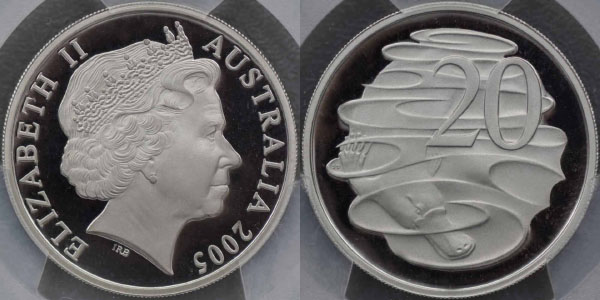 Unique: A proof 2005 twenty cent with the playpus reverse.
Unique: A proof 2005 twenty cent with the playpus reverse.
2006 Proof Two Cent Mature Bust in Silver
Like the 2005 proof platypus twenty cent, the 2006 silver two cent bearing Ian Rank-Broadley’s Elizabeth is a world-class rarity, currently known by just four coins. Prior to their discovery, rumours whirled about their existence, and it wasn’t long before an example appeared on the market. That coin was purchased by a north-west Sydney collector, who submitted it to PCGS. The coin subsequently scored a perfect 70. The second coin was acquired from a Melbourne source, and subsequently graded PR69DC by PCGS. A passionate coin collector, who is also from the north west of Sydney, obtained that coin, and to my knowledge, still has it in their collection. The third coin was purchased from yet another north-west Sydney collector, who had obtained the coin from a United Kingdom seller on Ebay. The fourth coin also came out of the United Kingdom.
The coins are found in the 2006 fine silver set. The standard silver two cent piece in that set contains the young bust of Queen Elizabeth by Arnold Machin. PCGS describes the coin a mule, but as both the copper and gold versions of the coin have identical designs, one could just as easily call the error version an off-metal strike too.
The number of 2006 proof silver mature bust two cent pieces in existence is not known, and as few collectors seem to be aware of the coin, the undiscovered coins may remain unidentified for many years to come.

Four known: A silver two cent with the mature bust.
2005 Proof One Dollar Mob of 'roos
Much has already been written about the famous 2005 proof mob of ‘roos one dollar coin. It was discovered by Melbourne coin dealer Downies, who featured the coin in their monthly catalogue. As a consequence, the coin is widely-known, and keenly sought-after. It is not as rare as the 2005 proof platypus twenty cent or the 2006 silver two cent with the mature bust, but is still extremely collectable.
You can read more about this coin here.
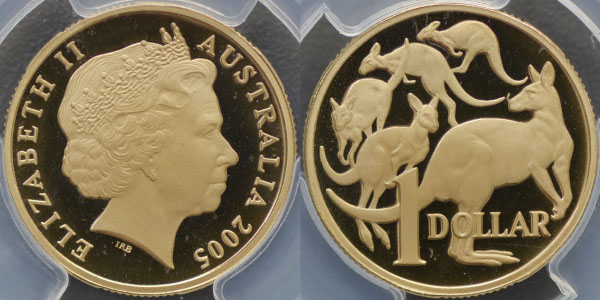 Twenty to forty coins known: A 2005 proof mob of 'roos one dollar.
Twenty to forty coins known: A 2005 proof mob of 'roos one dollar.
2009 Rosella One Dollar
Discovered by accident by the purchaser when he could not find the coin in the catalogue, the 2009 Rosella One Dollar coin bears the design of the 2011 Crimson Rosella One Dollar from the Air Series—but is dated 2009. The purchaser bought the coin out of the Mint Master Collection, where the coin was not identified as outstanding or unique in any way. Research revealed that in 2009 a series of coins featuring the Crimson Rosella was minted. This single coin was plucked from the mintage and impounded in the Mint Master Collection, as was the procedure at the time; the remaining mintage was not issued and subsequently destroyed. It is not publically known why the issue was never released to collectors, but the result is a unique coin with a surviving mintage of one. The purchaser submitted the coin to PCGS, where it was graded MS68, and it subsequently sold into a private collection. Its whereabouts are currently unknown (to me), but if you are the owner, please reach out to us here.

Unique: A 2009 rosella one dollar. Image courtesy of PCGS.
2009 Flying Fox One Dollar
The origin story of the 2009 Flying Fox One Dollar is identical to that of the 2009 Crimson Rosella One Dollar. Like the latter coin, the 2009 Flying Fox was plucked from a mintage of coins and then put aside in Mint Master Collection. The original mintage was subsequently destroyed, leaving behind a single survivor. The survivor was sold through the Mint Master Collection auction in 2015, but was not identified as particularly exceptional or outstanding. However, unlike the 2009 Rosella, the 2009 Flying Fox One Dollar was of an entirely unique design that does not appear on any other coin. (The Flying Fox One Dollar of 2011 has a very different design.) PCGS graded the coin MS68, and the coin was sold into a private collection. Like the 2009 Rosella, the 2009 Flying Fox has a surviving mintage of one and is unique.
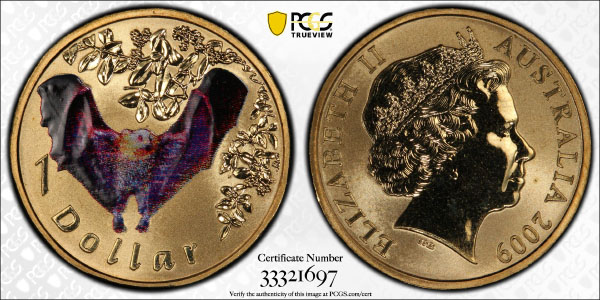 Unique: A 2009 flying fox one dollar. Image courtesy of PCGS.
Unique: A 2009 flying fox one dollar. Image courtesy of PCGS.
1992 Proof One Dollar Mob of ‘roos
Much has been written about the 1992 mob of ‘roos one dollar coin. The Royal Australian Mint annual report indicates an official mintage of 8,000 pieces, but none have been found in circulation. Numismatists and dealers believe that this figure is an error in reports, or may refer to another issue; either way, the facts are not known. What is known, however, is that at least one coin appeared at auction in 2012, was lost sometime after the auction, but then subsequently sold via Downies’ retail arm many years later. That coin had a proof-like appearance, and was described as having been struck on a partially-prepared proof blank. In 2019, numista.com user Renmia01 claimed to have purchased this elusive coin, and provided images of the coin at various angles. An image of the coin in a Downies presentation box also accompanied the post.
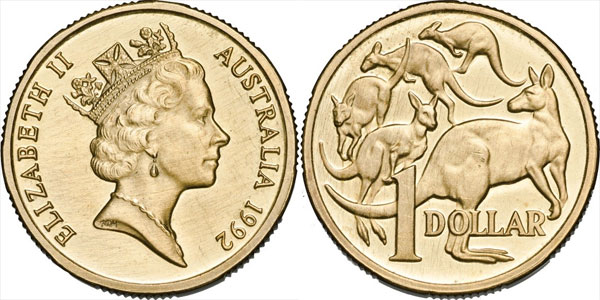 Unique: A 1992 mob of 'roos one dollar. Image courtesy of Downies.
Unique: A 1992 mob of 'roos one dollar. Image courtesy of Downies.
1977 Coat of Arms Fifty Cent
Another rarity issued under mysterious circumstances, the 1977 fifty cent with the coat of arms reverse was minted in small numbers. The exact mintage is not known, but “fewer than ten” seems to be the oft-quoted number; PCGS states a mintage of seven. Two specific examples have been identified in the last few years, one of which was a mint state example with specimen-like appearance. The second example has been certified by PCGS in the inexplicably low grade of AU55. Both coins should be considered extremely rare. The specimen-like example sold for $8,600 hammer in a Sydney auction in 2009; the catalogue hypothesised that the coin was struck as a trial.
 Fewer than ten known: A 1977 coat of arms fifty cent. Image courtesy of Noble Numismatics.
Fewer than ten known: A 1977 coat of arms fifty cent. Image courtesy of Noble Numismatics.
1988 Coat of Arms Fifty Cent
The 1988 fifty cent bearing the Stuart Devlin’s coat of arms was never meant to exist, but several examples in both mint state and proof have been discovered. PCGS describes the proof examples as minted out of silver, while the mint state coins appear to be minted out of the standard copper-nickel alloy. PCGS has graded two proof coins, with both coins exhibiting noticeable die polishing hairlines. While the mintage of both proof and mint state coins is not known, the mint state example is rarer than the proof. Currently, PCGS has graded just two proof examples and one mint state example. Several uncertified proof coins are also known, and are owned (as I understand it) by the one collector.
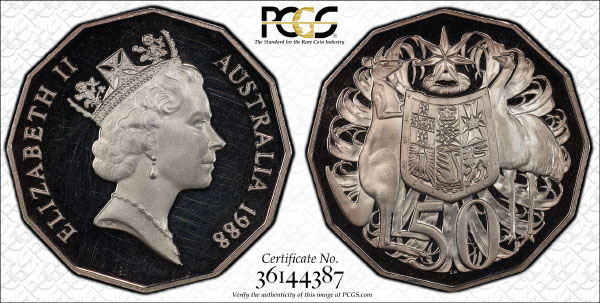
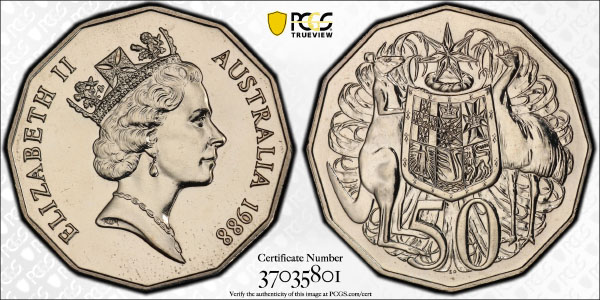 A proof and business strike 1988 coat of arms fifty cent. Both are known by only a few pieces. Images courtesy of PCGS.
A proof and business strike 1988 coat of arms fifty cent. Both are known by only a few pieces. Images courtesy of PCGS.
 Change website currency
Change website currency 







Comments